Looking for how to take notes, note-taking methods, and tips for taking better notes in class? Read this article till the end.

I remember, in my schooling and college days, I always used to be praised for my notes-taking system, and all my classmates used to ask me how do I take better notes and understand easily with my notes?
If this is what you’re also looking for then in this article, I am going to tell you exactly how to take notes and 4 note-taking methods, and more.
But before I give you my guide let me first tell you why you should take notes in class?
Research has shown that when you hear something you can only retain up to 5% unless you visit the material again but when you write also during classes you keep remembering the information for a longer time.
Benefits of Note-taking:
So with these benefits, you would have understood why you should take notes in college. Now let’s jump into the main topic…
How to take better notes in class?
When your professor teaches you something you must have been confused at that time about what should I jot down and when should I take notes during class?
So here I’m presenting 6 tips for taking better notes during your class…
1. Pre-read the material by yourself:
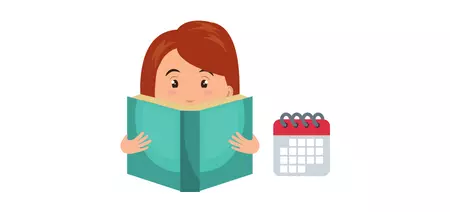
The subject or topic that you’re going to study in class, pre-read it by yourself at home or just half-hour before the class.
Whether you understand the material or not, doesn’t matter. Just take a survey and while reading focus on headings, subheadings, bold and bullet points, images, graphs, and more things that grab your attention.
Pre-reading is quite related to Pre-testing. The advantage of Pre-reading you get, when you study again the material by your professor, it will become easier for you to understand the material and connect the information that you noticed in pre-reading. And further, it will help you in taking better notes.
2. Write the Key-Points
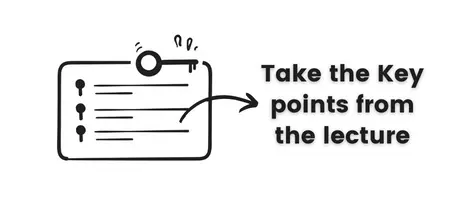
When your professor is teaching you or making you understand something, it’s important to write the points that you heard from him/her.
But, What should you write actually?
Don’t try to copy or jot down all the definitions and theories, taught by your professor, and that you’ll get easily in the book. Instead, focus and write only key points or important points when you hear from them.
Now, you must be thinking about how to identify those key points that I should take notes on?
Well, here are tips that will help you identify the important things that you should take in notes when your professor is teaching you…
- Headings and Subheadings (new terms)
- Dates and numbers
- Types or Parts
- Reasons
- Repeated words or concepts by your professor
- Things that you also noticed in pre-reading
Whether your classes are running online or offline, these key points you must consider while taking notes.
3. Don’t write when your professor is teaching you

Improve Your Study Skills – Overcome Most of Your Study Challenges with this Ebook!
Ever felt sluggish, distracted, or struggled with grades despite your efforts? These are the exact hurdles I tackle in this ebook. Whether it’s overcoming laziness, battling procrastination, or dealing with distractions, this guide has you covered.
As I said above it’s important to write the key points when your professor is teaching you, but it doesn’t mean you keep yourself busy in writing at that time.
During classes, listen to your professor very carefully, and focus on learning when he/she makes you understand and when they take small pauses then write those key points that you heard from them.
Don’t take notes about anything without understanding, if you don’t understand something or have some doubt ask your professor.
Remember, your first goal should be understanding and learning, then taking notes. Don’t focus on writing long information, if you don’t get time to take notes during classes, then you can take notes after the class also by recalling the information.
4. Find the Note-Taking System that works for you
Till now, you have understood what notes to take. Now let’s dive into 4 different types of note-taking systems and find out which note-taking system works for you.
The Cornell Method:
According to Wikipedia, The Cornell Notes system is a note-taking method devised in the 1950s by Walter Pauk, an education professor at Cornell University. Pauk advocated its use in his best-selling book How to Study in College.
This method provides you with a better format to take notes and organize your notes. According to the Cornell method, you divide your paper into 3 sections– Note-taking area, Cue column, and Summaries. (Look at the image below)
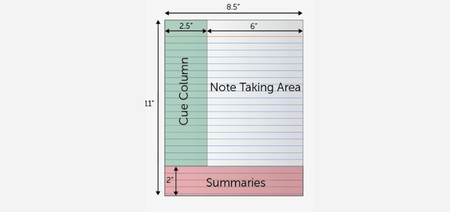
- Note-taking area: This is the main area where you make notes and write all the information, definitions, and concepts that your teacher allows you to write. If you can’t make time to write long information during classes then you can take notes in this section after the class.
- Cue column: This is the left side area where you should take notes during class and write only the key points that I discussed in the second tip. This is the most important section for effective note-taking during class.
- Summaries: This is the bottom area of the paper where you write the summaries or what you learned in today’s class. This section, you can fill at your home or right after the class.
This is a great note-taking system that is followed by most of the students. Diving your paper into 3 sections provides you with an easy format for pulling out major concepts and ideas for taking better notes.
The Outlining Method:
This is a very simple and common method for note-taking used by mostly college students.
According to the Outlining Method, In a paper first, you write the main topic (key points), and underneath you write sub-points and after the sub-points, you write the supporting thoughts or facts. (Look at the image below)

Many students use this method for note-taking unknowingly. Most of the speakers used this method to make a speech. Look at the above Table of content for this article, It’s written in Outlining method.
Like the Cornell method, you don’t need to divide the paper, you just keep writing the key points in a paper. In this method, you have to organize notes in systematic order so that you can easily understand the related points for the main topic.
Also, make sure when you use this method for note-taking, leave enough space after the main topic you write because you won’t have any idea about the sub-topics and supporting thoughts that will come next.
The Mind-mapping Method:
This is the method I used to use to take better notes. Even today I also use this for my work approach or making any strategy.
In the mind mapping method, you make a circle around the main topic and link it to all the points or topics which are related to it. And if any other linked topic is also important then consider it again the main topic and link it further to its related points.
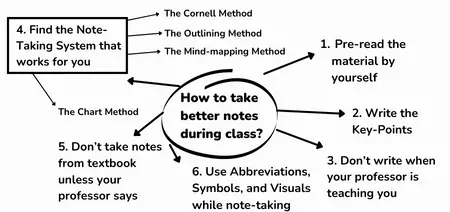
Take an eye at the above image and you will get to know exactly how mind-mapping works.
Remember, this note-taking system mostly works in the subjects where you have to write the reasons, types, and connected or linked topics. Here are 3 big benefits of the mind-mapping method…
- It helps you to explore subjects broadly and in-depth
- It helps you to make and Identify relationships between different topics
- It makes your study more interesting and develops your subject understanding.
The Chart Method:
This is the last note-taking system on my list. This is a very clean, easy, and good format for taking notes.
In this method, you make 3-4 columns or a chart on a paper, and in every column, you write the main topics as a heading, and underneath the main topics, you write the sub-topics and points that explain your main topics. Look at the image below…
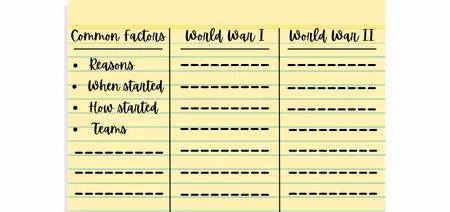
This method is also used in office work to make a schedule. Even, your syllabus, daily routine, and more are based on this chart method.
The Chart Method works great when you have to take notes about the comparison of something, Pros & Cons, making listing points or steps around How, When, types of questions.
This note-taking method structures your notes very well and helps you to understand and remember the information easily.
5. Don’t take notes from textbook unless your professor says
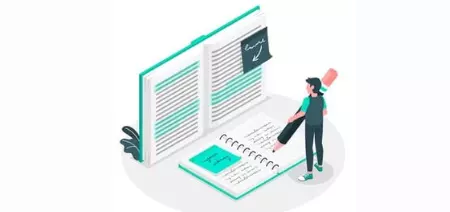
Books are great for reading and getting an in-depth guide. However, we all know textbook language is tough to understand, that’s why we take notes or your professor provides you notes. Isn’t it?
But, I have seen most of the students copy the book language and jot it down in their notes, which is not good at all. Remember, when you take notes during class don’t open your textbook to understand the information or take notes unless your professor says.
If you read your textbooks and like to take a few notes from books then I would suggest you use a pencil or highlighter and make underline the sentence in your book after the class.
And, If your professor allows you to take notes from the book then don’t copy the whole thing instead, write the key points and underline the information in your book.
6. Use Abbreviations, Symbols, and Visuals while note-taking
Instead of writing complete sentences and long information during taking notes in class, use abbreviations, symbols, and visuals like images, graphs, and more.
For writing the key points and taking notes during classes you might not get enough time when your professor is making you understand something. So use abbreviations to quickly write the key points.
Similarly, symbols and visuals are great ways to memorize something. Studies have shown that visuals are directly processed by our long-term memory. So, adding these things in your notes not only makes your notes beautiful but also you can remember the information for a longer time.
If you take notes online then using symbols and visuals can be easier for you but if you take handwritten notes then you may have to put in extra effort in making visuals. But remember, the harder one is the beneficial one.
Handwritten Notes Vs Typing Notes: Which one should you choose?

So till now, I have discussed how to take better notes still, you’ll have one question in mind- Should you take handwritten notes or digital notes?
Well, it depends on you what you prefer and where are you good at. However, according to one study, most students prefer hard copies or print for schoolwork. The researcher also asserts that digital reading makes it easier for students to become distracted and multitask.
It is also found that students who read a paper article will have a statistically significant difference in greater recall accuracy compared to those who read the same digital article using a tablet.
However, Slowly and steadily the craze of taking notes online is increasing with the best note-taking applications like Notion, Evernote, and more.
Digital notes are not only easy to take but also you can make changes in your notes easily and take backups. Also remember, for taking and studying with online notes you must have a laptop or Tab.
Now, you have to find your comfort. I personally like handwritten notes. However, if you want to use both methods then I would recommend you take handwritten notes in class and when you make fair notes then you can take digital notes.
Now It’s Your Turn:
So, in this article, I have shared with you 6 tips for taking better notes, 4 note-taking systems and what should you prefer handwritten notes Vs digital notes.
And, I hope you enjoyed this article and learned something new. Now, I would like to hear from you:
Which note-taking systems you’re going to use and what’s your view about handwritten notes or digital notes?
And, if you have any queries let me know in the comment also…

Thanks a lot sir it’s really wonderful blog….All the methods are good mind map is awesome..
Sir what student should do if the professor in the class are not teaching effectively moreover not even audible …in that case I have to prepare notes from my text books of law ….I found study tips very useful.
Once again 🙏Thank you so much for this wonderful post
Hey Jasmeet,
I’m glad you liked the blog and found our tips useful. I appreciate you taking the time to leave a comment.
Thank you very much for this blog and podcast however I need more illustrations on the mind map method of taking notes. Thanks